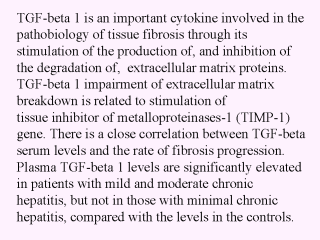 |
Plasma TGF-beta 1 levels
increase in parallel with the histological degree of necroinflammation and of liver
fibrosis [97]. Patients with no progression of fibrosis have significantly lower (59 ng/mL
+/- 22) TGF-beta serum levels than patients with progressive disease (115 ng/mL +/- 20)
[98]. A TGF-beta level below 75 ng/mL was predictive for stable disease [98]. Among
biochemical markers of liver injury, a significant correlation with TGF-beta 1 and TIMP-1
was demonstrated in respect to aminotransferase activities (r = 0.62) [93]. Plasma
TGF-beta 1 levels positively correlate with blood levels of PIIIP and IV-C [97]. These
results suggest that plasma TGF-beta 1 level is a useful marker in assessing the situation
of liver active fibrogenesis in patients with chronic viral hepatitis, and could be
suggested for use as a possible early non-invasive marker of liver fibrosis useful for CHC
management [97]. |
